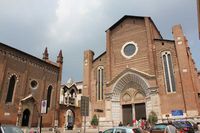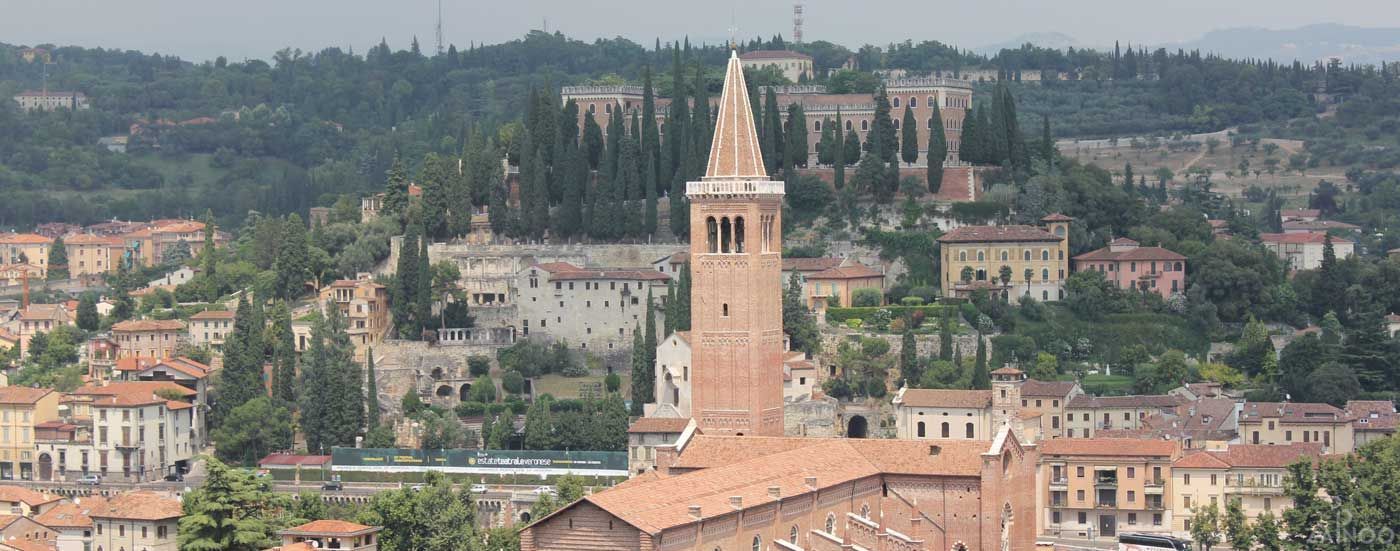Chiesa Santa Anastasia
Church
Chiesa Sant’Anastasia
The largest church in Verona
The church of St. Anastasia is the largest church in Verona. The massive Gothic brick building was built by the Dominicans between the 13th and the 15th century. Originally two churches built by King Theoderic, the churches of Anastasius and Remigio were located here. In 1261 both churches were taken over by the Dominicans and developed over two centuries of work into a single mighty church. Although the impressive façade was never completed, the new Chiesa Sant’Anastasia was dedicated in 1481.
Inside the Chiesa Sant’Anastasia
The church of Santa Anastasia is a perfect example of the Italian-dominated Gothic style. The interior of the church is dark and the high cross-ribbed vault is supported by massive circular columns. By the first columns you can see two dwarfs – popularly known as “the hunchbacks” – bending under the weight of two fonts. The three-nave church is divided by a transept just in front of the altar. Six chapels are located at the ends of the transept. Six richly decorated altars with pictures and illustrations by famous artists such as Danese Cataneo, Sanmicheli, Liberale da Verona and Francesco Caroto decorate the right-hand nave and the side wall of the transept.
The chapels and frescoes of the Chiesa Sant’Anastasia
Set slightly further back, the chapel of the crucifixion represents the oldest part of the church of St. Anastasia and marks the place where the small church’s eponymous predecessor once stood. The portrait of the crucifixion dates from the 15th century and the tomb on the left-hand side is by Giansello da Folgaria. In the next chapel, the Cavalli chapel, you can admire the church’s first highlight, the beautiful fresco of “Madonna with three saints and the Cavalli family” by Altichiero. It was created in 1375 and depicts three noble knights who entrust three members of the Cavalli family to the mother of God.
The Pellegrini chapel just next door attracts attention mainly on account of its entirely brickwork construction. In the main chapel in the centre you can see the tomb of the Scaliger commander Cortesia Serego on the left-hand side and the great fresco “The last judgement” by Turone on the right-hand wall of the choir.
Cappella Giusti
The most famous fresco of the Chiesa Sant’Anastasia is located in the Capella Giusti in the left-hand transept. It was here that Antonio Pisanello (1380-1455) painted the fresco “Departure of St. George to fight the dragon”. It is considered to be the high point and at the same time the end point of the Gothic style in northern Italy. It shows Saint George, who is jumping into the saddle to save the beautiful princess from the dragon. Although it is still in the high Gothic tradition, the fresco already shows first signs of the early Renaissance with strong foreshortening and an unusual depth for this period, which you can explore best by looking at the horse.
Cappella San Pietro Martire
If you leave the Chiesa Sant’Anastasia through the main entrance, you can see the Gothic tomb of the nobleman Castelbarco just left over the gate. The small chapel of San Pietro Martire (also called Cappella San Giorgetto) is located right next to the tomb. It is dedicated to Saint Peter of Verona and contains some beautiful frescoes.
Entrance
€ 2,50
Opening hours
Discounts
free entrance with VeronaCard









Tweet